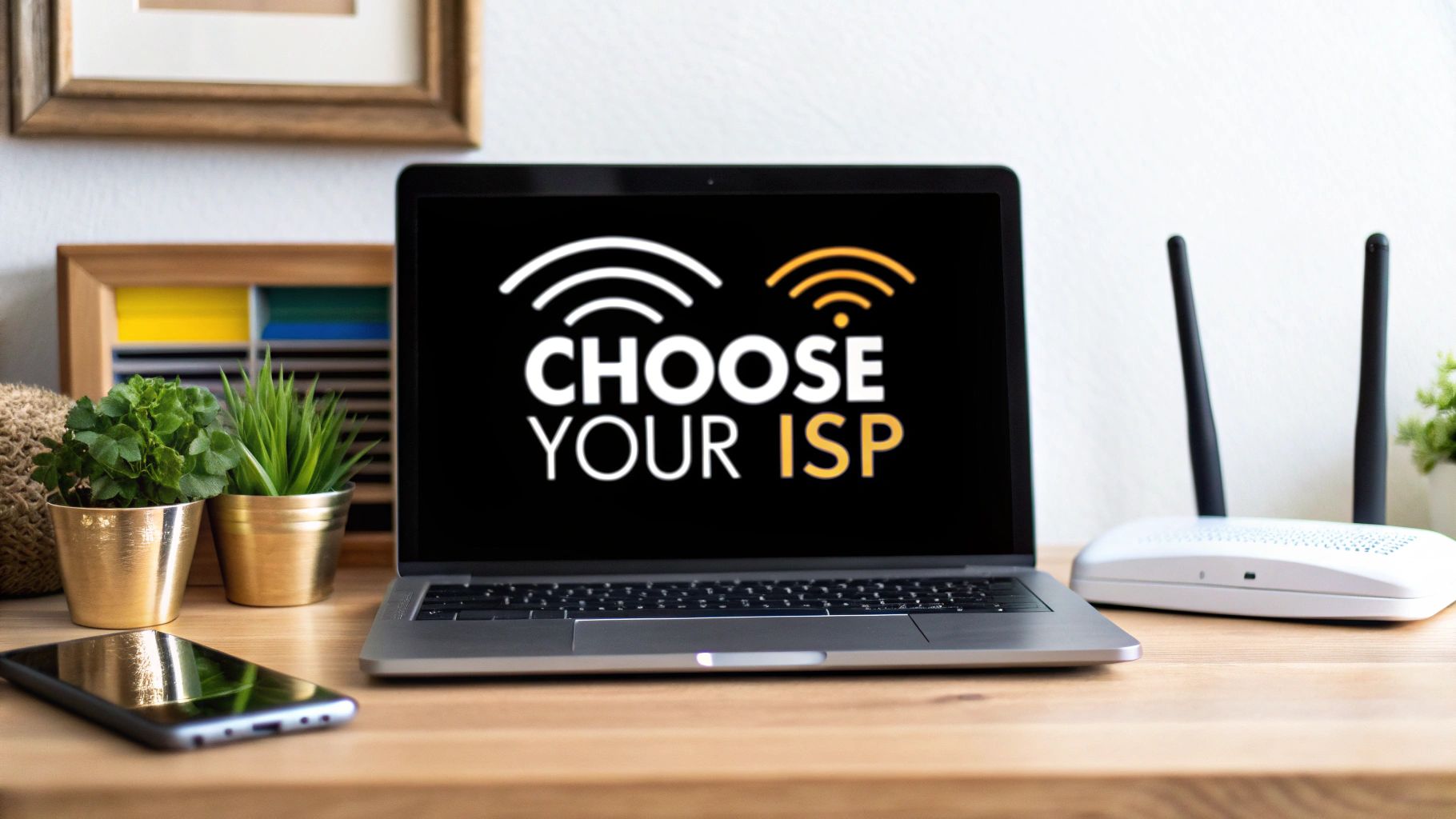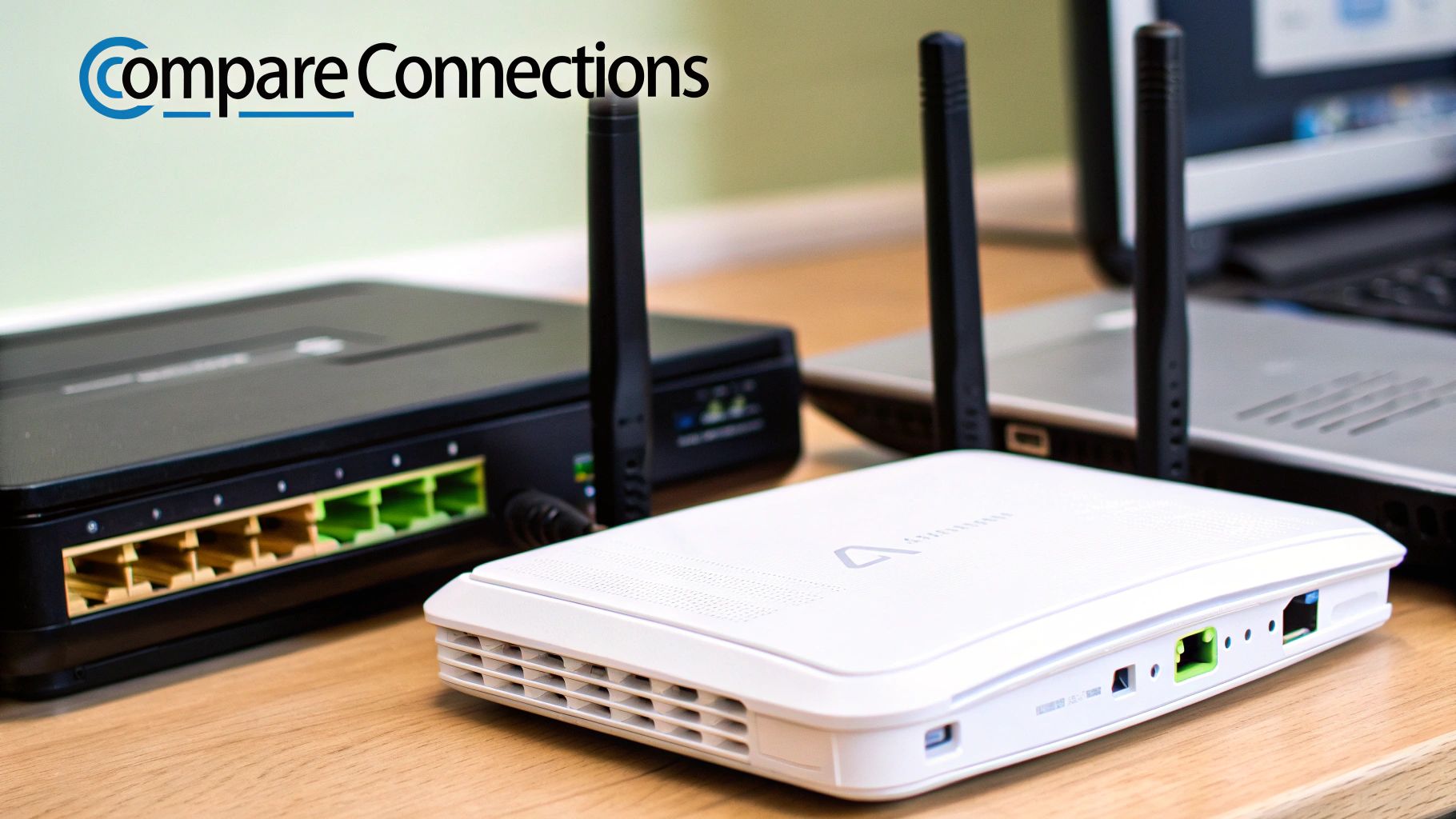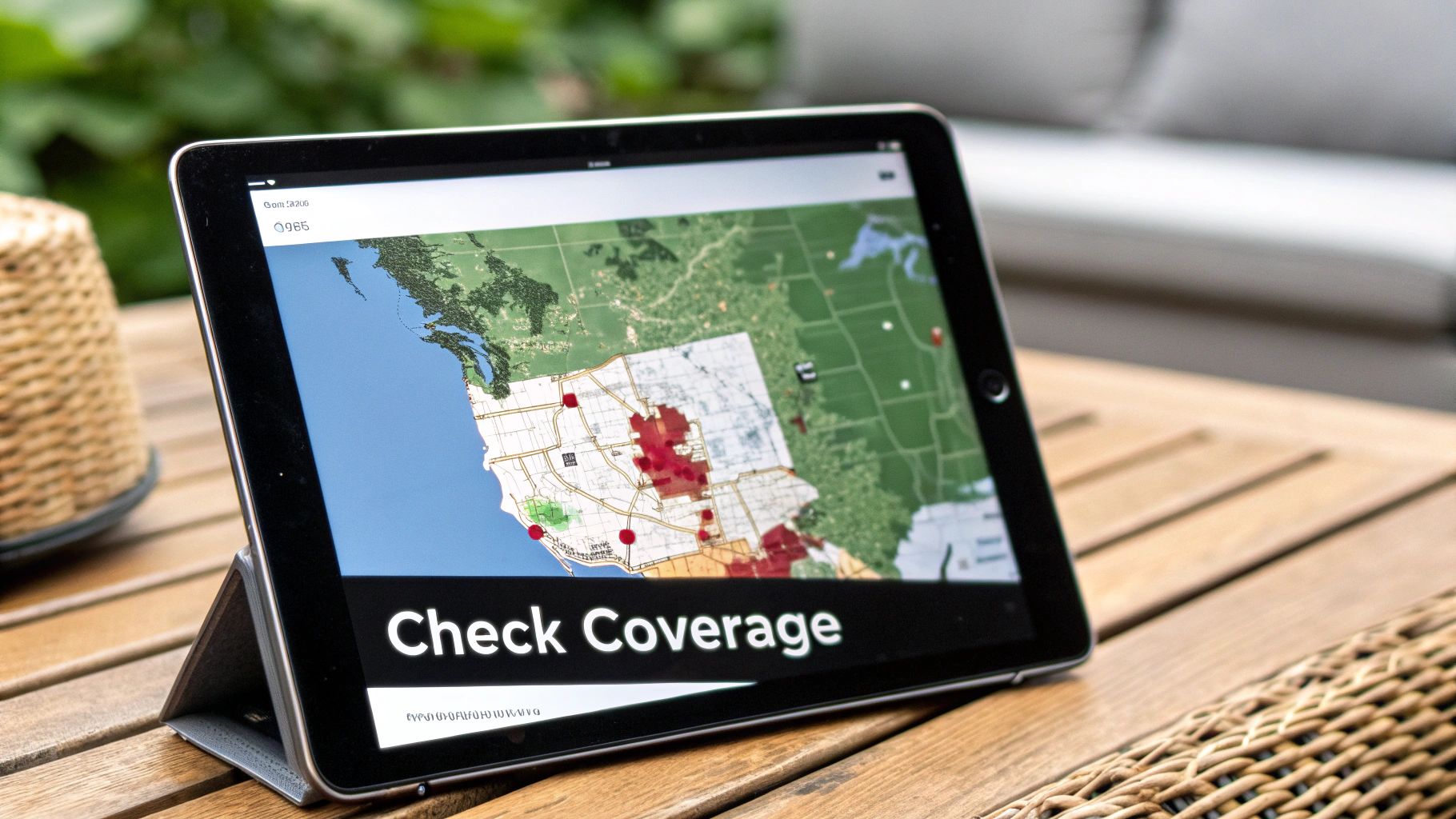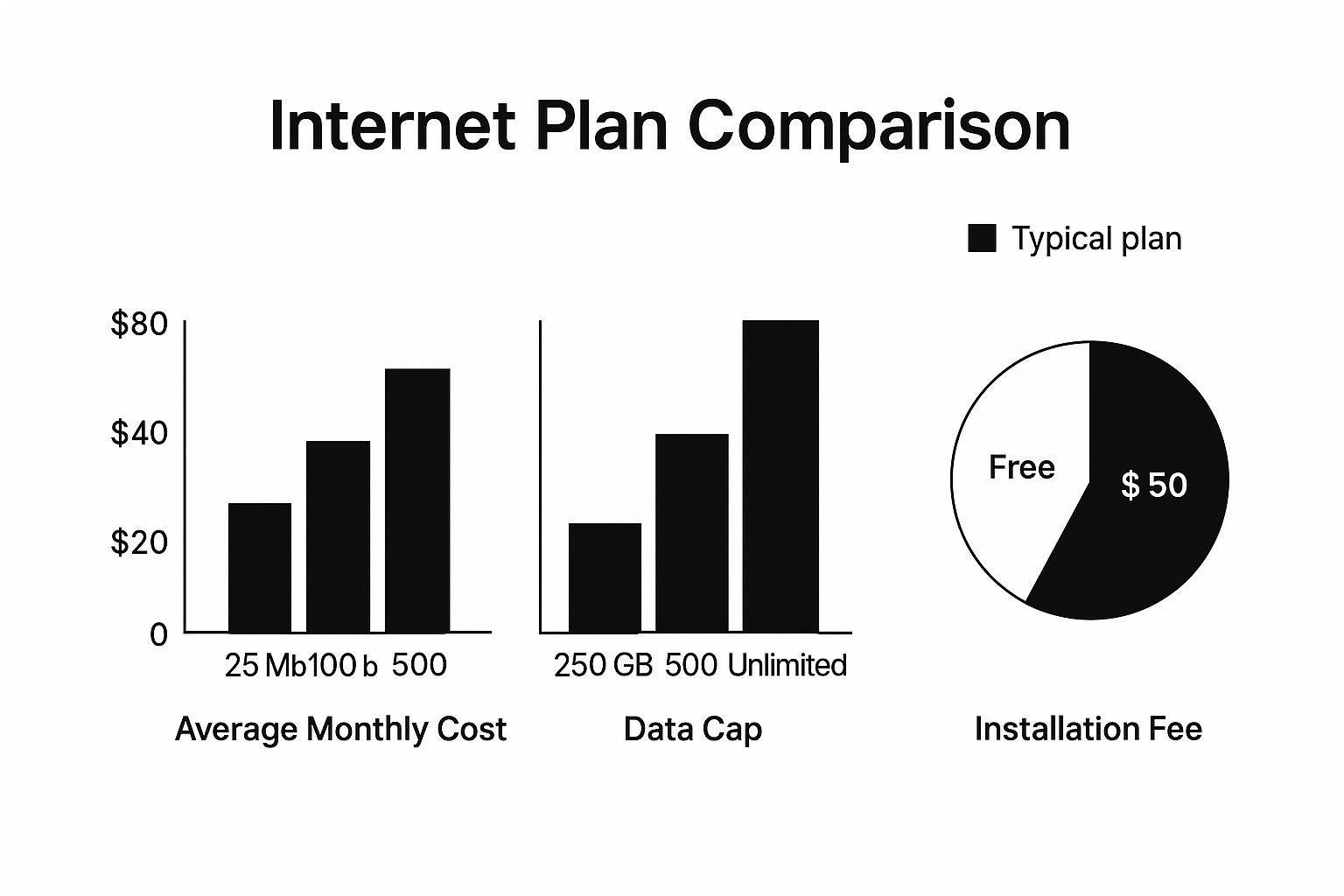How to Choose Internet Provider in the UK | Expert Tips
How to Choose Internet Provider in the UK | Expert Tips

Feeling swamped by the sheer number of broadband deals out there? I get it. But honestly, picking the right internet provider boils down to a few key things: the real-world speed your home actually needs, what you're willing to spend, and which companies can even connect to your address.
This guide is designed to cut through all the marketing fluff and give you a straightforward plan.
Finding Your Perfect Internet Provider in Minutes
Let's be real, choosing an internet provider feels like a chore. The secret is to figure out what you need before you even glance at a single deal.
Think about your home. Are you a solo streamer who just needs enough speed for Netflix? A busy family juggling work calls, online gaming, and tablets all at once? Or maybe you're working from home and a rock-solid connection is non-negotiable.
Nailing this down first gives you a personal checklist. It lets you instantly dismiss the offers that don't make sense for you and zero in on the plans that genuinely fit your life and budget. You'll stop trying to compare apples and oranges and start making a properly informed choice.
What Kind of Internet User Are You?
Before you start looking at providers, let’s quickly figure out your user profile. This is what will really determine the speed you need.
- The Light User: This is usually someone living alone or with a partner. You're mostly browsing websites, checking emails, and streaming HD video on one or two devices at a time. A basic superfast plan will likely do the job perfectly.
- The Family Hub: Picture this: multiple people all online at the same time. Someone's on a Zoom call, another is gaming, and a third is streaming a 4K film. For this kind of household, a faster fibre connection is a must to prevent everything from grinding to a halt.
- The Power User or Creator: If you're a serious online gamer where every millisecond counts, a YouTuber uploading massive video files, or you run a business from home, you need the best. A full fibre or gigabit connection isn’t a luxury; it's essential for getting top speeds and iron-clad reliability.
The good news? The UK is more connected than ever. As of late 2023, an impressive 97% of households can get superfast broadband (that’s over 30 Mbps). Even better, 78% of us can now access lightning-fast gigabit speeds. Full fibre, the undisputed champion of reliability, is available to around 57% of UK homes. For a deeper dive into UK broadband availability, Choose.co.uk is a great resource.
Get this right from the start, and you'll avoid the classic mistakes: either paying a fortune for speed you'll never use or, even worse, signing up for a plan that just can't keep up. Knowing what you need is your biggest advantage.
To help you visualise this, I've put together a quick table matching internet speeds to different household needs.
Matching Internet Speed to Your Household Needs
This table breaks down the common speed tiers and shows what kind of use they're really built for.
Hopefully, this gives you a much clearer idea of where you fit in and what kind of speed you should be looking for.
If you want to see which providers are leading the pack on performance, take a look at our detailed breakdown of the fastest internet providers in the UK. It's a fantastic starting point for your search.
What Do Internet Speeds Actually Mean For You?

When you're shopping for a new internet provider, it's easy to get lost in a sea of technical jargon. They throw around terms like megabits, gigabits, and latency, but what does any of that actually mean for your Friday night Netflix binge or that critical Monday morning Zoom call? Let's cut through the noise and translate these numbers into real-world performance.
Getting this right is the key to avoiding two common pitfalls: either overpaying for speeds you simply don't need or, even worse, getting stuck with a plan that's constantly buffering. The goal isn't just about finding the fastest connection on paper, but about striking that perfect balance between performance and price for your home.
Download vs. Upload Speeds: What’s the Real Difference?
Most providers love to shout about their download speeds. This is the speed at which your devices pull data from the internet, and it’s what powers your film streaming, web browsing, and file downloading. It's definitely important, but it's only half the story.
Upload speed is how quickly you can send data from your devices to the internet. This is an absolute game-changer if you work from home, create content, play online games, or even just make a lot of video calls. A sluggish upload speed is the culprit behind your video freezing on a Teams call or why it takes an eternity to back up your photos to the cloud.
For a much deeper dive, our guide on how much broadband speed you really need breaks this down in plain English, helping you pinpoint exactly what your daily routine demands.
A lot of standard fibre plans have what’s known as asymmetrical speeds. This means the upload speed is just a fraction of the download speed (think 70 Mbps download but only 18 Mbps upload). If you frequently upload large files or need crystal-clear video calls, you should seriously consider a plan with symmetrical speeds, where the upload and download speeds are identical.
Figuring Out Your Home's Internet Needs
Before you can choose the right plan, you’ve got to get a handle on what you’re currently using. Take a moment and think about every single device connected to your Wi-Fi—I promise it’s more than just your laptops and phones.
- Smart TVs: Streaming in 4K on platforms like Netflix or Disney+ can gobble up 25 Mbps all by itself.
- Gaming Consoles: Online gaming needs a stable, low-latency connection, but the real bandwidth hog is downloading new games, which can be massive files, often over 100 GB.
- Smart Home Gadgets: Your video doorbell, smart thermostat, and security cameras are all constantly chatting with the internet, sending and receiving small packets of data.
- Work & School: A single person on a high-definition video call can easily use 2-4 Mbps for both uploading and downloading simultaneously.
When you start adding up the demands of a busy household, you can see how a basic plan gets overloaded fast, leading to a lot of frustration. A family of four, with two people working from home and two kids streaming or gaming, could easily require a connection of 150 Mbps or more just to keep everything running smoothly.
Making the right call can feel complicated, but it doesn't have to be. To simplify everything, our top-recommended provider has an excellent, easy-to-use tool that assesses your household's needs and suggests the ideal plan.
It takes all the guesswork out of the equation. By using my affiliate link to sign up, you not only help support my work but also get direct access to their best deals. These are perfectly matched to your lifestyle, ensuring you get the performance you actually need without wasting a penny.
Looking Beyond the Price to Find Real Value

It’s easy to get drawn in by a low monthly fee. But let's be honest, that cheap deal means nothing when your connection gives up the ghost during a crucial video call or right at the climax of a family film night. When you’re figuring out how to choose an internet provider, the real value is in the reliability and the service you get, not just the number on the bill.
Think of it this way: a low price might be the bait, but reliability is what actually keeps you happy long-term. A provider with a rock-solid reputation means you can work, stream, and game without those infuriating dropouts.
Decoding Customer Satisfaction and Reliability
Customer satisfaction scores and reliability ratings are your secret weapon. They’re a window into the actual, day-to-day experience of real customers. These aren't just abstract numbers; a high score usually signals a stable network, which tells you the company has put serious money into its infrastructure.
That investment is everything. A provider with a strong network can deliver a more consistent service, often because your data has fewer hoops to jump through. Fewer "hops" means lower latency, which translates to a much smoother and faster experience for you, whether you're battling it out online or uploading hefty files for work.
As you dig through customer reviews, keep an eye out for recurring themes. One bad review? It could just be a one-off. But if you see dozens of people all complaining about the same issue—like the internet slowing to a crawl every evening or completely unhelpful support staff—that’s a massive red flag you can't afford to ignore.
Recent surveys give a pretty clear picture of who’s leading the pack in the UK. YouFibre, for instance, was recently voted the best broadband provider overall, while Zen Internet was hailed as the best widely available provider. When you look at raw performance, Brillband takes the crown for the fastest average download speed at a blistering 523 Mbps, and Trooli is rated as the most reliable. You can dive deeper into the numbers with this comprehensive broadband statistics overview.
Evaluating Customer Service Reputation
Sooner or later, something will go wrong. It’s inevitable. When it does, the quality of a provider's customer service suddenly becomes the most important thing in the world. Will you be trapped in a soul-destroying automated phone menu for an hour, or can you get through to a real person who can actually fix your problem?
Here are a few things I always check when sizing up a provider's support team:
- Availability: Are they on call 24/7? What are the options for getting in touch—phone, live chat, email?
- Responsiveness: I head straight to review sites and forums. How quickly do they actually respond to customer problems?
- Problem Resolution: Do customers say their issues get sorted on the first contact, or are they stuck in a loop of calling back again and again?
A provider that nails customer service shows it genuinely cares about its users. YouFibre, for example, consistently gets praised for its excellent support. In a different way, providers like Vodafone are showing a commitment to customers by rolling out social tariffs to help low-income households get connected.
Finding a provider that ticks all the boxes—great reliability, solid support, and a fair price—can feel like a tall order. That’s why I’ve done the legwork for you, identifying providers that consistently deliver fantastic all-around value.
By using my exclusive affiliate links to sign up, you can lock in their best current offers. I'll only direct you to companies I trust to provide a dependable, well-supported service that’s worth every penny. It’s the best way for you to get a top-tier deal while also supporting the work I do to bring you this advice.
How to Read Contracts and Avoid Hidden Fees
Let’s be honest, the price you see advertised is almost never the price you’ll actually pay. If you want to know how to choose an internet provider without getting ripped off, you have to become a master of the small print. It sounds like a chore, I know, but you don’t need a law degree to spot the usual tricks that turn a sweet deal sour.
So many providers hook you with a tempting low price, only for it to jump up halfway through your contract or go through the roof once the initial term ends. A recent Which? investigation found that millions of us get stung by these price hikes every single year. That’s exactly why you need to look past that shiny headline number.
Decoding the Details
Before you even think about signing, you need to get a crystal-clear picture of the total cost. Hidden fees love to hide in the contractual jargon, so it’s best to go in armed with a checklist.
- Mid-Contract Price Hikes: Does the contract say the price is fixed? Or does it mention that it can rise with inflation (CPI/RPI) plus an extra percentage? This is a really common clause these days and can add a nasty surprise to your monthly bill.
- Out-of-Contract Rates: What’s the plan when your first 12 or 24 months are up? The price can often double. Make a note of your contract end date so you can renegotiate or switch before that happens.
- Installation and Equipment Fees: Is there a one-off fee for the setup? Are they going to charge you for the router, or is it genuinely free?
- Cancellation Penalties: What happens if you need to leave early? Early termination fees can be incredibly steep, sometimes costing you hundreds of pounds.
Getting to grips with the full cost of the service—not just the flashy promo price—is the single most important thing you can do. It's the difference between a smart buy and a year of frustration.
Match the Contract Length to Your Life
Choosing between a longer 24-month contract and a more flexible 12-month deal really just comes down to your personal situation. A longer commitment will usually get you a cheaper monthly price, which is great if you own your home or you know you’re not moving any time soon.
But if you’re renting or your plans are a bit up in the air, a 12-month or even a rolling 30-day contract gives you priceless freedom. You might pay a bit more each month, but that flexibility is often worth it. It’s a classic trade-off: savings versus freedom.
I know that wading through these contracts is draining. That’s why I've made it my mission to find and partner with providers known for their transparent pricing and straightforward terms. They ditch the confusing legal speak and make it obvious what you’re paying for.
To save you the headache, I've pulled together the best deals from these transparent providers in one spot. By using my affiliate link to sign up, you can secure a plan with confidence, knowing there are no nasty surprises waiting for you. You get a fair price, and you also help support the independent advice I provide here.
Checking Availability and Making the Switch Seamlessly

You've done the homework, weighed up your needs, and scouted out the providers. Now it’s time for the moment of truth. This is where you find out exactly which services you can actually get at your address. It’s the final step in turning all that research into a real-world decision.
The easiest way to do this is with an online postcode checker. Forget the nationwide adverts—what really matters is which cables are physically connected to your street. A postcode checker cuts through the noise and gives you the facts.
From Postcode to Connection
Once you pop your postcode in, you’ll probably see a few different connection types. Knowing the lingo is crucial, so you know what you’re paying for.
- Fibre to the Cabinet (FTTC): This is the most common type of “fibre” broadband. A fibre optic cable runs to a green street cabinet, but the last stretch into your home relies on old copper phone lines. It's a huge improvement on ancient ADSL, but your speed depends on how far your house is from that cabinet.
- Full Fibre (FTTP): This is the best of the best. A fibre optic cable runs straight into your home, giving you blistering speeds and rock-solid reliability. If you can get it, it's almost always the one to go for.
In the UK, a few big names dominate the market, which often dictates what's available near you. As of early this year, BT Group (which owns BT, EE, and Plusnet) is the UK's largest provider, serving over 8.8 million homes and holding around 30% of the market. Sky Broadband and Virgin Media aren't far behind, each with close to 5.8 million customers. Their massive presence means they’ve invested heavily in infrastructure, so you're more likely to find them in your area. You can dig deeper into UK provider market shares at Uswitch.com.
Don't write off the smaller providers, though. A new wave of companies, known as "altnets," is rolling out full-fibre networks at an incredible pace. They often pop up with amazing deals in places the big guys have overlooked, so it always pays to check.
Making the Switch Pain-Free
Worried about the headache of switching? You really don't need to be. The process is surprisingly simple these days. In most cases, your new provider handles all the tricky bits for you. They’ll coordinate directly with your old provider to manage the changeover, ensuring a smooth transition with little to no downtime.
I've found that some of the newer kids on the block are especially brilliant at making this effortless. For instance, in our hands-on BRSK review, we saw firsthand how they manage the entire process, from the moment you place your order right through to installation day.
To make this final step as easy as possible, I recommend using our trusted partner’s availability checker. By clicking my affiliate link and signing up on their site, you can instantly see which plans are available for your home and lock in one of their exclusive deals. It’s the fastest way to get from searching to sorted, all without the faff.
Answering Those Last-Minute Questions
Even after you've done all the research, a few nagging questions can pop up right when you’re ready to pull the trigger. Knowing how to choose an internet provider is often about getting these final doubts cleared up, so you can sign up feeling completely confident.
Let's run through some of the most common queries people have just before they commit. Getting these sorted is the final hurdle to a faster, more reliable connection.
What Happens to My Email Address If I Switch?
This is a classic worry, and a valid one. What happens to that old email address you’ve had for a decade, the one ending in @btinternet.com or @talktalk.net? The honest answer is: it’s risky to rely on it. Some providers might let you keep it, sometimes for a small monthly fee, but many will simply delete it once you’re no longer a customer.
My personal advice? Make the switch to a provider-neutral email service like Gmail or Outlook before you change your internet. They're completely free, and it means your email address is yours for life, no matter which broadband provider you're with.
Will I Need a New Phone Line Installed?
This really comes down to the technology your new provider uses. If you're just switching between two providers on the Openreach network (think BT, Sky, Plusnet, and most other fibre-to-the-cabinet providers), you almost certainly won't need a new line. It’s usually a seamless switch.
However, if you're moving to a company that runs its own separate network—like Virgin Media or one of the new full-fibre "altnets"—then yes, an engineer will need to visit. They’ll have to install a brand-new line into your home. The good news? This is almost always included for free as part of your new package.
This infographic breaks down some of the key cost and feature differences you'll come across while shopping around.

As you can see, while faster speeds naturally cost a bit more, the real savings often come from nabbing deals with free installation and steering clear of restrictive data caps.
I hope this guide has armed you with the confidence and the know-how to find your perfect internet deal. My mission at Humble Reviewer is to slice through the marketing jargon and give you clear, practical advice you can actually put to use. We do the deep dives into providers, contracts, and real-world performance so you don't have to. For more unbiased reviews and expert tips to help you make smarter buying decisions, please visit https://www.humblereviewer.com.
